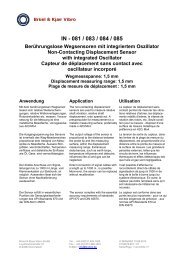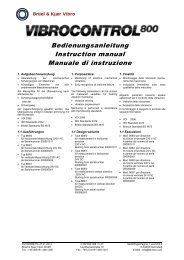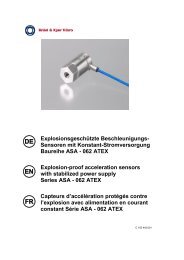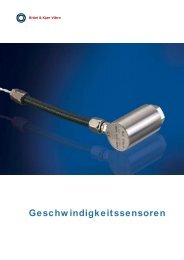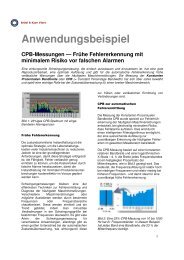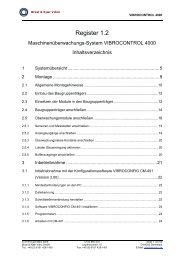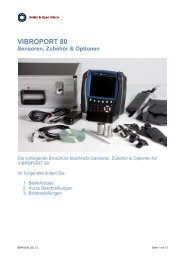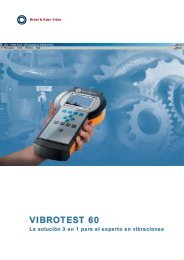Allgemeine Erdungsempfehlung General grounding ...
Allgemeine Erdungsempfehlung General grounding ...
Allgemeine Erdungsempfehlung General grounding ...
Create successful ePaper yourself
Turn your PDF publications into a flip-book with our unique Google optimized e-Paper software.
Erdung Grounding Tierra<br />
• Schutzleiter und Erder für die<br />
EMV-Sicherheit können Potentialunterschiede<br />
aufweisen (siehe<br />
Abschnitt 4).Deshalb sind bereits<br />
vor der Montage die lokalen<br />
Erdverhältnisse zu prüfen.<br />
• Die Auflagepunkte für Erdleiter<br />
müssen frei von Schmutz und Lack<br />
sein.<br />
• Bezugs- und Erdleiter müssen<br />
ausreichend niederohmig und<br />
induktivitätsarm sein (großer<br />
Querschnitt, kurze Wege, flächige<br />
Ankopplung). Sie sollten immer<br />
sternpunktförmig verbunden<br />
werden (Sammelschienen,<br />
Ringleiter usw.) und dürfen nie<br />
durch Geräte oder Schaltkreise<br />
hindurch weiterverbunden werden.<br />
• Benutzte Erder müssen<br />
regelmäßig auf ihre Wirksamkeit<br />
(Widerstand nach Erde) überprüft<br />
werden.<br />
• Beachten Sie auch unsere<br />
Sicherheitshinweise, die jeder<br />
technischen Dokumentation als<br />
gesonderte Druckschrift beiliegen.<br />
4.2.2 Abschirmen gegen<br />
Störungen (EMV)<br />
Erd- und Potentialverhältnisse<br />
prüfen !<br />
Bevor Kabelschirme aufgelegt<br />
werden, müssen die örtlichen Erd-<br />
und Potentialverhältnisse beider<br />
Auflagestellen geprüft werden.<br />
Werden dabei kritische Potentialunterschiede<br />
festgestellt (siehe<br />
Abschnitt 4), müssen betreiberseitig<br />
geeignete Maßnahmen im Sinne<br />
dieser <strong>Erdungsempfehlung</strong><br />
getroffen werden.<br />
• Protective conductors and grounds<br />
for the EMV security can exhibit<br />
potential differences<br />
(see section 4). Therefore local<br />
potential differences must be<br />
checked before an installation.<br />
• The connection point for the<br />
ground cable must be free of dirt<br />
and paint.<br />
• Reference and <strong>grounding</strong> cables<br />
must be sufficiently low in<br />
resistance, and free of inductance<br />
(large cross-sectional area,<br />
shortest path, flat connection).<br />
They should always be connected<br />
in a star shape (bus-bars, ringcircuit<br />
etc.) and may not be fed<br />
through the instrument or switching<br />
circuits to further connection<br />
points.<br />
• Grounds which are used must be<br />
regularly checked for their<br />
efficiency (resistance to ground).<br />
• Observe our Security<br />
Instructions which accompany all<br />
technical documentation we issue<br />
in the form of a separate brochure.<br />
4.2.2 Shielding against<br />
interference (EMV)<br />
Check ground and potential<br />
differences!<br />
Before cable shields are connected<br />
the local ground and potential<br />
differences at the ends of the<br />
installation must be checked. If<br />
critical potential differences are<br />
found (see section 4) sutiable<br />
measures must be undertaken on<br />
the part of the end-user regarding<br />
these <strong>grounding</strong> recommendations.<br />
• Conductores protectores y tierra<br />
para la seguridad EMV puedan<br />
mostrar diferencias de potenciales<br />
(ver la sección 4).<br />
Por consiguiente, diferencias<br />
locales de potenciales deben ser<br />
chequeadas antes de proceder a<br />
una instalación.<br />
• El punto de conexión para el cable<br />
de tierra debe estar exento de<br />
suciedades y pintura.<br />
• Cables de referencia y de tierra<br />
deben contar con una resistencia<br />
lo suficientemente baja y estar<br />
exentos de induc-tancia (gran área<br />
de sección transversal, trayectoria<br />
más corta, conexión plana).<br />
Siempre deben estar conectados<br />
en astroide (barra-ómnibus,<br />
circuito anular, etc.) y no necesitan<br />
ser alimentados a través del<br />
instrumento o de circuitos de<br />
conmutación a puntos adicionales<br />
de conexión.<br />
• Las tierras, que se utilizan deben<br />
ser controladas períodicamente<br />
para verificar su rendimiento<br />
(resistencia a la puesta a tierra).<br />
• Familiarizase con nuestras<br />
Instrucciones de seguridad, que<br />
van anexadas a toda documentación<br />
técnica y que editamos en<br />
forma de un folleto separado.<br />
4.2.2 Blindaje contra<br />
interferencias (EMV)<br />
Chequear la tierra y las<br />
diferencias de potencial!<br />
Previo a conectar los blindajes de<br />
cable es preciso controlar la tierra<br />
local y las diferencias de potencial<br />
en los extremos de la instalación.<br />
En el caso de evidenciarse<br />
diferencias críticas de potencial<br />
(ver la sección 4) deben emprenderse<br />
medios adecuados en la parte<br />
correspondiente al consumidor<br />
final, con respecto a las presentes<br />
recomendaciones de puesta a<br />
tierra.<br />
Seite/Page 12 von/of/de 26 © Erdung DESP 12.4.2006



